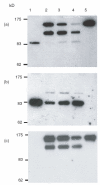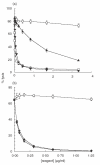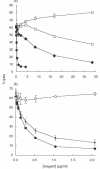Coupling complement regulators to immunoglobulin domains generates effective anti-complement reagents with extended half-life in vivo
- PMID: 12165074
- PMCID: PMC1906445
- DOI: 10.1046/j.1365-2249.2002.01924.x
Coupling complement regulators to immunoglobulin domains generates effective anti-complement reagents with extended half-life in vivo
Abstract
Complement activation and subsequent generation of inflammatory molecules and membrane attack complex contributes to the pathology of a number of inflammatory and degenerative diseases, including arthritis, glomerulonephritis and demyelination. Agents that specifically inhibit complement activation might prove beneficial in the treatment of these diseases. Soluble recombinant forms of the naturally occurring membrane complement regulatory proteins (CRP) have been exploited for this purpose. We have undertaken to design better therapeutics based on CRP. Here we describe the generation of soluble, recombinant CRP comprising rat decay accelerating factor (DAF) or rat CD59 expressed as Fc fusion proteins, antibody-like molecules comprising two CRP moieties in place of the antibody Fab arms (CRP-Ig). Reagents bearing DAF on each arm (DAF-Ig), CD59 on each arm (CD59-Ig) and a hybrid reagent containing both DAF and CD59 were generated. All three reagents inhibited C activation in vitro. Compared with soluble CRP lacking Fc domains, activity was reduced, but was fully restored by enzymatic release of the regulator from the Ig moiety, implicating steric constraints in reducing functional activity. In vivo studies showed that DAF-Ig, when compared to soluble DAF, had a much extended half-life in the circulation in rats and concomitantly caused a sustained reduction in plasma complement activity. When given intra-articularly to rats in a model of arthritis, DAF-Ig significantly reduced severity of disease. The data demonstrate the potential of CRP-Ig as reagents for sustained therapy of inflammatory disorders, including arthritis, but emphasize the need for careful design of fusion proteins to retain function.
Figures







Similar articles
-
Human and rodent decay-accelerating factors (CD55) are not species restricted in their complement-inhibiting activities.Immunology. 2000 Aug;100(4):462-70. doi: 10.1046/j.1365-2567.2000.00066.x. Immunology. 2000. PMID: 10929073 Free PMC article.
-
Targeting of functional antibody-decay-accelerating factor fusion proteins to a cell surface.J Biol Chem. 2001 Jul 20;276(29):27290-5. doi: 10.1074/jbc.M100436200. Epub 2001 May 14. J Biol Chem. 2001. PMID: 11352906
-
Complement receptor 2-mediated targeting of complement inhibitors to sites of complement activation.J Clin Invest. 2003 Jun;111(12):1875-85. doi: 10.1172/JCI17348. J Clin Invest. 2003. PMID: 12813023 Free PMC article.
-
Therapeutic inhibition of the complement system. Y2K update.Front Biosci. 2000 Sep 1;5:E63-81. doi: 10.2741/asghar. Front Biosci. 2000. PMID: 10966868 Review.
-
Complement therapeutics; history and current progress.Mol Immunol. 2003 Sep;40(2-4):159-70. doi: 10.1016/s0161-5890(03)00111-1. Mol Immunol. 2003. PMID: 12914822 Review.
Cited by
-
Nontransgenic hyperexpression of a complement regulator in donor kidney modulates transplant ischemia/reperfusion damage, acute rejection, and chronic nephropathy.Am J Pathol. 2003 Oct;163(4):1457-65. doi: 10.1016/S0002-9440(10)63503-1. Am J Pathol. 2003. PMID: 14507653 Free PMC article.
-
Pharmacological and biological antiviral therapeutics for cardiac coxsackievirus infections.Molecules. 2011 Oct 11;16(10):8475-503. doi: 10.3390/molecules16108475. Molecules. 2011. PMID: 21989310 Free PMC article. Review.
-
Expression of an engineered soluble coxsackievirus and adenovirus receptor by a dimeric AAV9 vector inhibits adenovirus infection in mice.Gene Ther. 2015 Jun;22(6):458-66. doi: 10.1038/gt.2015.19. Epub 2015 Mar 19. Gene Ther. 2015. PMID: 25786873
-
Anticomplement therapy.Biologics. 2008 Dec;2(4):671-85. doi: 10.2147/btt.s2753. Biologics. 2008. PMID: 19707448 Free PMC article.
-
Therapeutic potential of complement modulation.Nat Rev Drug Discov. 2010 Jan;9(1):43-56. doi: 10.1038/nrd3011. Epub 2009 Dec 4. Nat Rev Drug Discov. 2010. PMID: 19960015 Review.
References
-
- Morgan BP, Meri S. Membrane proteins that protect against complement lysis. Springer Semin Immunopathol. 1994;15:369–96. - PubMed
-
- Morgan BP, Harris CL. London: Academic Press; 1999. Complement Regulatory Proteins.
-
- Kinoshita T, Lavoie S, Nussenzweig V. Regulatory proteins for the activated third and fourth components of complement (C3b and C4b) in mice. II. Identification and properties of complement receptor type 1 (CR1) J Immunol. 1985;134:2564–70. - PubMed
-
- Reid KBM, Bentley DR, Campbell RD, Chung LP, Sim RB, Kristensen T, Tack BF. Complement proteins which interact with C3b or C4b. A superfamily of structurally related proteins. Immunol Today. 1986;7:230–4. - PubMed
Publication types
MeSH terms
Substances
Grants and funding
LinkOut - more resources
Full Text Sources
Other Literature Sources
Research Materials
Miscellaneous

